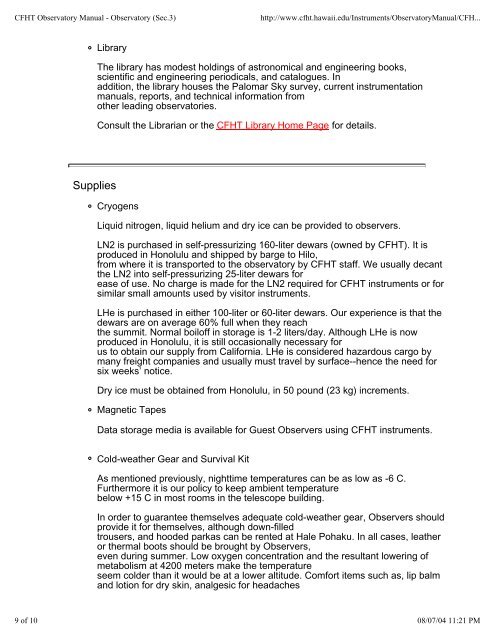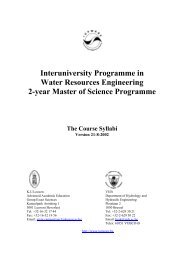CFHT operating manual - Homepage Usask
CFHT operating manual - Homepage Usask
CFHT operating manual - Homepage Usask
Create successful ePaper yourself
Turn your PDF publications into a flip-book with our unique Google optimized e-Paper software.
<strong>CFHT</strong> Observatory Manual - Observatory (Sec.3) http://www.cfht.hawaii.edu/Instruments/ObservatoryManual/CFH...<br />
Library<br />
Supplies<br />
The library has modest holdings of astronomical and engineering books,<br />
scientific and engineering periodicals, and catalogues. In<br />
addition, the library houses the Palomar Sky survey, current instrumentation<br />
<strong>manual</strong>s, reports, and technical information from<br />
other leading observatories.<br />
Consult the Librarian or the <strong>CFHT</strong> Library Home Page for details.<br />
Cryogens<br />
Liquid nitrogen, liquid helium and dry ice can be provided to observers.<br />
LN2 is purchased in self-pressurizing 160-liter dewars (owned by <strong>CFHT</strong>). It is<br />
produced in Honolulu and shipped by barge to Hilo,<br />
from where it is transported to the observatory by <strong>CFHT</strong> staff. We usually decant<br />
the LN2 into self-pressurizing 25-liter dewars for<br />
ease of use. No charge is made for the LN2 required for <strong>CFHT</strong> instruments or for<br />
similar small amounts used by visitor instruments.<br />
LHe is purchased in either 100-liter or 60-liter dewars. Our experience is that the<br />
dewars are on average 60% full when they reach<br />
the summit. Normal boiloff in storage is 1-2 liters/day. Although LHe is now<br />
produced in Honolulu, it is still occasionally necessary for<br />
us to obtain our supply from California. LHe is considered hazardous cargo by<br />
many freight companies and usually must travel by surface--hence the need for<br />
six weeks’ notice.<br />
Dry ice must be obtained from Honolulu, in 50 pound (23 kg) increments.<br />
Magnetic Tapes<br />
Data storage media is available for Guest Observers using <strong>CFHT</strong> instruments.<br />
Cold-weather Gear and Survival Kit<br />
As mentioned previously, nighttime temperatures can be as low as -6 C.<br />
Furthermore it is our policy to keep ambient temperature<br />
below +15 C in most rooms in the telescope building.<br />
In order to guarantee themselves adequate cold-weather gear, Observers should<br />
provide it for themselves, although down-filled<br />
trousers, and hooded parkas can be rented at Hale Pohaku. In all cases, leather<br />
or thermal boots should be brought by Observers,<br />
even during summer. Low oxygen concentration and the resultant lowering of<br />
metabolism at 4200 meters make the temperature<br />
seem colder than it would be at a lower altitude. Comfort items such as, lip balm<br />
and lotion for dry skin, analgesic for headaches<br />
9 of 10 08/07/04 11:21 PM

















